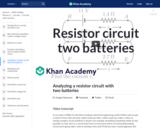
An example of simplifying a seemingly complicated resistor circuit. Created by Willy McAllister.
- Subject:
- Physical Science
- Physics
- Material Type:
- Lesson
- Provider:
- Khan Academy
- Provider Set:
- Khan Academy
- Author:
- Sal Khan
- Date Added:
- 08/10/2021

An example of simplifying a seemingly complicated resistor circuit. Created by Willy McAllister.

Laszlo Tisza was Professor of Physics Emeritus at MIT, where he began teaching in 1941. This online publication is a reproduction the original lecture notes for the course "Applied Geometric Algebra" taught by Professor Tisza in the Spring of 1976. Over the last 100 years, the mathematical tools employed by physicists have expanded considerably, from differential calculus, vector algebra and geometry, to advanced linear algebra, tensors, Hilbert space, spinors, Group theory and many others. These sophisticated tools provide powerful machinery for describing the physical world, however, their physical interpretation is often not intuitive. These course notes represent Prof. Tisza's attempt at bringing conceptual clarity and unity to the application and interpretation of these advanced mathematical tools. In particular, there is an emphasis on the unifying role that Group theory plays in classical, relativistic, and quantum physics. Prof. Tisza revisits many elementary problems with an advanced treatment in order to help develop the geometrical intuition for the algebraic machinery that may carry over to more advanced problems. The lecture notes came to MIT OpenCourseWare by way of Samuel Gasster, '77 (Course 18), who had taken the course and kept a copy of the lecture notes for his own reference. He dedicated dozens of hours of his own time to convert the typewritten notes into LaTeX files and then publication-ready PDFs. You can read about his motivation for wanting to see these notes published in his Preface below. Professor Tisza kindly gave his permission to make these notes available on MIT OpenCourseWare.
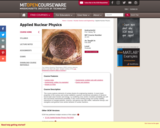
Fundamentals of nuclear physics for engineering students. Basic properties of the nucleus and nuclear radiations. Elementary quantum mechanical calculations of bound-state energies and barrier transmission probability. Binding energy and nuclear stability. Interactions of charged particles, neutrons, and gamma rays with matter. Radioactive decays. Energetics and general cross-section behavior in nuclear reactions.
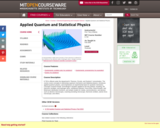
Elementary quantum mechanics and statistical physics. Introduces applied quantum physics. Emphasizes experimental basis for quantum mechanics. Applies Schrodinger's equation to the free particle, tunneling, the harmonic oscillator, and hydrogen atom. Variational methods. Elementary statistical physics; Fermi-Dirac, Bose-Einstein, and Boltzmann distribution functions. Simple models for metals, semiconductors, and devices such as electron microscopes, scanning tunneling microscope, thermonic emitters, atomic force microscope, and more.
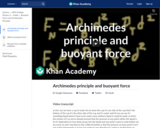
Introduction to Archimedes' principle and buoyant force. Created by Sal Khan.
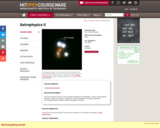
Galactic dynamics: potential theory, orbits, collisionless Boltzmann equation, etc. Galaxy interactions. Groups and clusters; dark matter. Intergalactic medium; x-ray clusters. Active galactic nuclei: unified models, black hole accretion, radio and optical jets, etc. Homogeneity and isotropy, redshift, galaxy distance ladder. Newtonian cosmology. Roberston-Walker models and cosmography. Early universe, primordial nucleosynthesis, recombination. Cosmic microwave background radiation. Large-scale structure, galaxy formation.
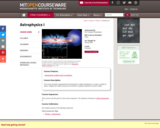
Size and time scales. Historical astronomy. Astronomical instrumentation. Stars: spectra and classification. Stellar structure equations and survey of stellar evolution. Stellar oscillations. Degenerate and collapsed stars; radio pulsars. Interacting binary systems; accretion disks, x-ray sources. Gravitational lenses; dark matter. Interstellar medium: HII regions, supernova remnants, molecular clouds, dust; radiative transfer; Jeans' mass; star formation. High-energy astrophysics: Compton scattering, bremsstrahlung, synchrotron radiation, cosmic rays. Galactic stellar distributions and populations; Oort constants; Oort limit; and globular clusters.
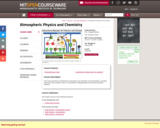
This course provides an introduction to the physics and chemistry of the atmosphere, including experience with computer codes. It is intended for undergraduates and first year graduate students.
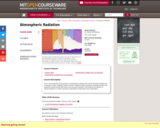
Introduction to the physics of atmospheric radiation and remote sensing including use of computer codes. Radiative transfer equation including emission and scattering, spectroscopy, Mie theory, and numerical solutions. Solution of inverse problems in remote sensing of atmospheric temperature and composition.
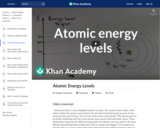
In this video, David explains how an atom can absorb and emit photons with particular values of energy and how to determine the allowed values.

This is the second of a two-semester subject sequence beginning with Atomic and Optical Physics I (8.421) that provides the foundations for contemporary research in selected areas of atomic and optical physics. Topics covered include non-classical states of light–squeezed states; multi-photon processes, Raman scattering; coherence–level crossings, quantum beats, double resonance, superradiance; trapping and cooling-light forces, laser cooling, atom optics, spectroscopy of trapped atoms and ions; atomic interactions–classical collisions, quantum scattering theory, ultracold collisions; and experimental methods.
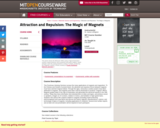
This Freshman Advising Seminar surveys the many applications of magnets and magnetism. To the Chinese and Greeks of ancient times, the attractive and repulsive forces between magnets must have seemed magical indeed. Through the ages, miraculous curative powers have been attributed to magnets, and magnets have been used by illusionists to produce "magical" effects. Magnets guided ships in the Age of Exploration and generated the electrical industry in the 19th century. Today they store information and entertainment on disks and tapes, and produce sound in speakers, images on TV screens, rotation in motors, and levitation in high-speed trains. Students visit various MIT projects related to magnets (including superconducting electromagnets) and read about and discuss the history, legends, pseudoscience, science, and technology of types of magnets, including applications in medicine. Several short written reports and at least one oral presentation will be required of each participant.
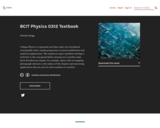
College Physics is organized such that topics are introduced conceptually with a steady progression to precise definitions and analytical applications. The analytical aspect (problem solving) is tied back to the conceptual before moving on to another topic. Each introductory chapter, for example, opens with an engaging photograph relevant to the subject of the chapter and interesting applications that are easy for most students to visualize.
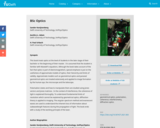
This book treats optics at the level of students in the later stage of their bachelor or the beginning of their master. It is assumed that the student is familiar with Maxwell’s equations. Although the book takes account of the fact that optics is part of electromagnetism, special emphasis is put on the usefulness of approximate models of optics, their hierarchy and limits of validity. Approximate models such as geometrical optics and paraxial geometrical optics are treated extensively and applied to image formation by the human eye, the microscope and the telescope.
Polarisation states and how to manipulate them are studied using Jones vectors and Jones matrices. In the context of interference, the coherence of light is explained thoroughly. To understand fundamental limits of resolution which cannot be explained by geometrical optics, diffraction theory is applied to imaging. The angular spectrum method and evanescent waves are used to understand the inherent loss of information about subwavelength features during the propagation of light. The book ends with a study of the working principle of the laser.

Play with objects on a teeter totter to learn about balance. Test what you've learned by trying the Balance Challenge game.
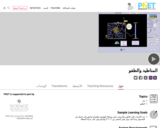
Experiment with a helium balloon, a hot air balloon, or a rigid sphere filled with different gases. Discover what makes some balloons float and others sink.
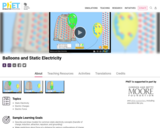
Students explore static electricity by rubbing a simulated balloon on a sweater. As they view the charges in the sweater, balloon, and adjacent wall, they gain an understanding of charge transfer. This item is part of a larger collection of simulations developed by the Physics Education Technology project (PhET). The simulations are animated, interactive, and game-like environments.
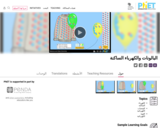
Why does a balloon stick to your sweater? Rub a balloon on a sweater, then let go of the balloon and it flies over and sticks to the sweater. View the charges in the sweater, balloons, and the wall.
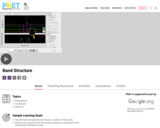
Explore the origin of energy bands in crystals of atoms. The structure of these bands determines how materials conduct electricity.
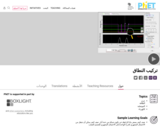
Explore the origin of energy bands in crystals of atoms. The structure of these bands determines how materials conduct electricity.